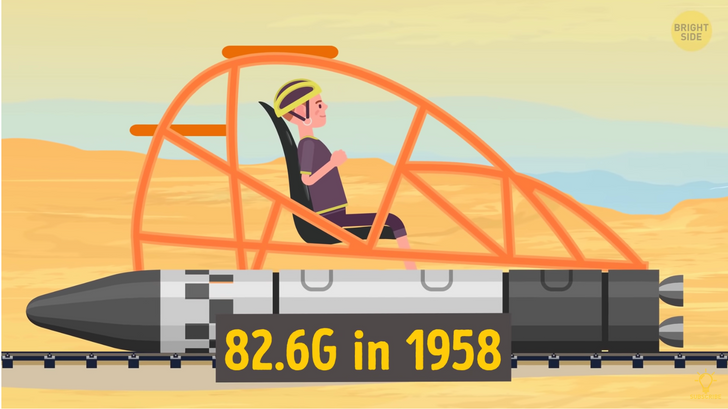15 People Whose Day Was Ruined by a Dramatic Fail


Ok, place those goggles over your eyes, strap in, and don’t forget to hold on tight! We’re going to see how fast we can really go! Long legs on a tall, yet muscular frame... not exactly the norm when compared to the shorter builds of short distance runners. But the fastest man alive makes it look easy to move that fast!
So far, the fastest anyone has run is just over 27 miles per hour, a speed reached briefly by sprinter Usain Bolt at the halfway point of his world record 100-meter dash! And humans can go even faster! The top speed we could reach may come down to how quickly the muscles in our body can move. Our muscles should be able to reach speeds as fast as 40 mph, the reason we can’t do it is that we’re in the air for too long!
Our limbs can only take a certain amount of force when they strike the ground. That’s why on skates you’re able to outpace a runner, gliding allows for more traction! What’d make us run a lot faster is simple...ish! Longer legs, REALLY wide hips, or extra legs... like an insect! I’d give running on all fours a try, it would be fun at least.

In 2016, speed records weren’t just broken on the running track, they were broken on the ski slopes in France! The world record for downhill skiing belongs to an Italian ski instructor and mountain guide! In 2016, assisted only by gravity, the instructor set a human land-speed record of around 158 miles per hour, skiing across the zone near the bottom of a course in just over 2 seconds! Well, I can barely stand up on skis, let alone move half that fast!
The fastest a Tiger beetle can sprint is up to 5 miles per hour. Doesn’t sound that fast really but consider this: it’s covering 120 of its body lengths in a single second! For comparison, Bolt covers about 6 body lengths per second. To match this beetle, he’d have to run at 480 miles per hour! That’s twice as fast as a Peregrine Falcon!
Tiger beetles have extremely sharp eyesight for insects, but while they’re running, the world turns into a featureless smudge! This means the beetle has to stop every now and then to see where it’s going!

So they’re pretty fast, but there’s a mite, a special mite, whose speed is equivalent to a human running roughly 1,300 mph! Take that Tiger beetle! At its quickest, this sesame seed-size mite can move 322 body lengths per second! Wow! Most cats run 0 times their body length for the majority of the day!
While we’re not going to be moving that fast anytime soon, we’ve got a few tricks up our sleeve, thanks to our big brains. We can use technology! Ooh! The fastest we’ve traveled on land over 1 mile is 763 mph. It was done back in 1997 in Nevada, in a Thrust SSC. That’s a big improvement from the first holder of the record! In 1898, a French man hit the actually pretty amazing speed of 39 miles per hour in his electric powered car!
Through the air, we’ve traveled at Mach 3.3, that’s around 2,100 miles per hour! It’s all thanks to the fastest jet aircraft in the world, the Lockheed SR-71 Blackbird. Amazingly, this plane doesn’t have a top speed! The only thing limiting its speed is temperature! If it was allowed to fly as fast as it wanted, it would literally melt in midair!

On water, the speed record is just over 275 knots, or a little over 317 mph! A jet-powered hydroplane called the Spirit of Australia did it back in 1978! Not bad if you want to get to your favorite fishing spot quickly! In 1896, there weren’t that many driving laws.
But still, Walter Arnold decided to break one of them and became the first man in history to receive a speeding ticket! The speed limit at the time was 2 miles per hour! You could’ve walked faster, and most people did. But that was too slow for Arnold, who decided to race through the town at 8 miles per hour! Eventually, he was caught and received a 1 shilling fine! Quite hefty for the time!
A man named Felix was taken over 127,000 ft into the edge of space in a balloon that, when fully inflated, was about the size of the Statue of Liberty! Having no choice but to jump out, he eventually reached the fastest free-fall speed ever: 843 miles per hour, in a specially designed suit of course! Landing back on solid ground in just over 9 minutes, he became the first person to break the sound barrier in free fall!

The fastest speed a human has ever traveled is around 25,000 miles per hour! The crew of Apollo 10 reached this on May 26th, 1969! This was also the highest speed ever reached by a manned vehicle! Are you feeling the hankering for speed yet? Good news!
The earth rotates once roughly every 24 hours. Math, math, math... that means that the Earth and you, are spinning at around 1,000 miles per hour! That’s not including how fast we’re all moving through space on this giant rock! We’re zipping along at 18 miles per second! That’s 67,000 miles per hour through the dark vacuum of space!
Our sun and the Milky Way appear to be moving at an average speed of 448,000 mph through space! While that sounds extremely fast, and it is, it’d still take about 230 million years to travel all the way around the Milky Way! So you’re probably moving a lot faster than you thought you were, but there’s a good reason you’re not a human puddle right now.

Speed obviously isn’t the issue, the real issue is acceleration! Changes in speed are expressed in G-forces, which just means the acceleration of an object relative to Earth’s gravity.
If you’re sitting on the sofa, you’re experiencing 1 G. Most of us can withstand up to 4-6G, like on a rollercoaster. Some pilots can manage up to about 9G for a second or two. But sustained G-forces are a big problem.
Some pilots wear special high-G suits and are trained to flex their torso muscles to keep blood from whooshing out of their heads, and into their legs. They can still operate their aircraft properly at about 9Gs.

The record for temporary Gs is an amazing 82.6Gs! Riding a rocket-powered sled backward in 1958, Eli Beeding Jr hit the brakes and stopped in a 10th of a second, as part of testing for space travel. Blacking out but only suffering back bruises, it was a remarkable demonstration of the body’s resilience to short bursts of deceleration!
More than 100 years ago, a super famous scientist named Einstein came up with an idea called relativity. There was an experiment that tested this out with two clocks set to the exact same time. One clock stayed on Earth, while the other flew on a commercial plane.

After the airplane returned from its trip around the world, the two clocks were compared. The clock on the fast-moving plane was slightly behind the other one! So, yes, time travel is a real thing if you’re going faster than another object. Another place times slows down is when you’re in line at the check-out stand at the supermarket. But hey, it’s all relative!
The safest place to test high speed travel is space, it’s an empty vacuum after all! But imagine speeding through space: anything the size of a grain of sand would become a high-speed projectile! The real danger, though, would be small hydrogen atoms just floating around!
The hydrogen would shatter into particles that’d pass into the ship; it wouldn’t be pretty! Your spacecraft would also heat up really quickly too! Sounds dangerous. You go first.











